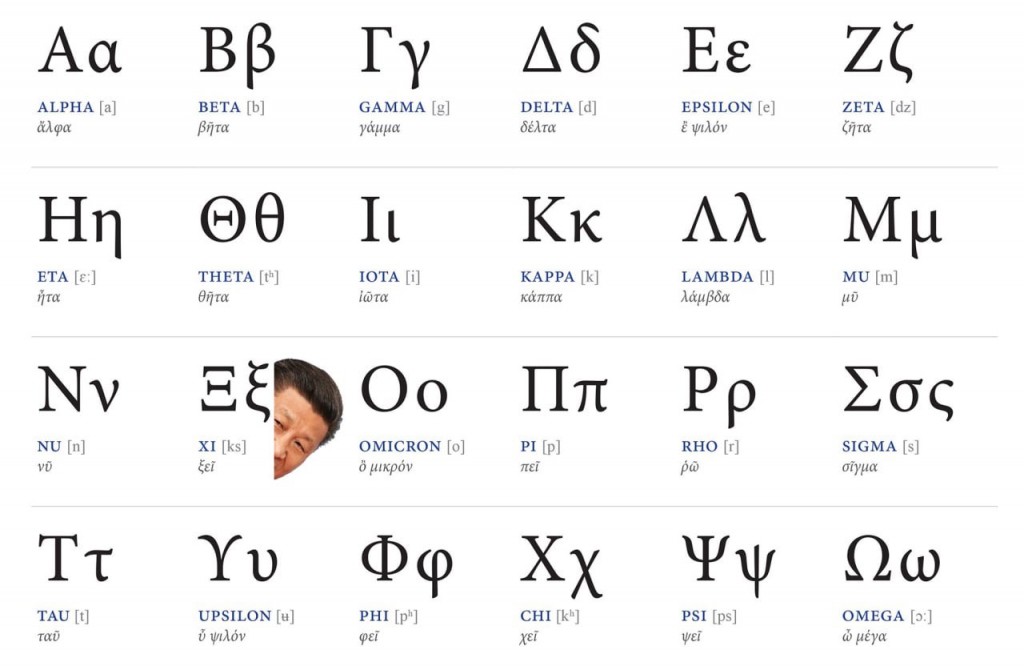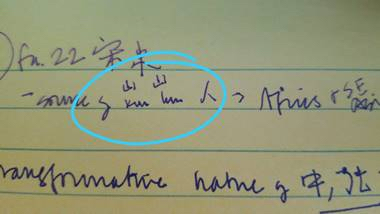Archive for Alphabets
December 29, 2021 @ 9:47 am· Filed by Victor Mair under Alphabets, Diglossia and digraphia, Humor, Language play, Writing systems
Occasionally I see pinyin (spelling) interspersed with Sinographs (usually for phonetic annotation), but this one threw me for a loop:
Yěxǔ (jué duì) shì, gāi lǐngyù zuì qiángdà de jiǎngzhě zhènróng.
也许(jué duì)是,该领域最强大的讲者阵容。
"Perhaps (definitely) it's the case that this is the strongest lineup of speakers in this field.
It occurs about two thirds of the way down in this Chinese article.
Read the rest of this entry »
Permalink
December 21, 2021 @ 10:41 pm· Filed by Victor Mair under Alphabets, Romanization, Spelling, Topolects
Tweet from Alan DAI:
[Click on the photograph to see the complete Twitter thread, which has additional illustrations of printed Latinxua texts.]
Read the rest of this entry »
Permalink
November 28, 2021 @ 12:55 pm· Filed by Victor Mair under Alphabets, Language and medicine, Language and politics, Names
"WHO — You cannot be Xi-rious! The WHO’s decision to skip the Greek letter Xi in its ludicrous naming system shows exactly who controls it", by David Spencer, Taiwan News, Contributing Writer, 2021/11/28:

(source)
Read the rest of this entry »
Permalink
October 24, 2021 @ 2:18 pm· Filed by Victor Mair under Acronyms, Alphabets, Diglossia and digraphia, Writing systems
Since the vast majority of inputting in the PRC is done via Hanyu Pinyin, netizens are thoroughly familiar with the alphabet and use it regularly as part of the Chinese writing system.
One common usage for the alphabet in the PRC is acronymically to designate frequently encountered Mandarin phrases. In "The Chinese Internet Slang You Need to Know in 2021", CLI (10/19/21), Anias Stambolis-D'Agostino introduces six popular online acroyms:
1. yyds (永远的神)
永远的神 (yǒngyuǎn de shén; yyds) means “eternal God” and describes an outstanding person or thing. It's similar to the saying GOAT (Greatest of All Time) in English. The phrase is often used by fans to praise their idols or simply to describe something they are fond of.
For example:
-
- 桂林米粉太好吃了,桂林米粉就是yyds!
- Guìlín mǐfěn tài hàochī le, Guìlín mǐfěn jiùshì yyds.
- Guilin rice noodles are delicious, they’re just yyds!
Here's another example:
-
- 李小龙的中国功夫太厉害了,他就是yyds!
- Lǐxiǎolóng de Zhōngguó gōngfū tài lìhài le, tā jiùshì yyds
- Bruce Li’s kung fu skills are so good, he’s such a yyds!
Read the rest of this entry »
Permalink
September 25, 2021 @ 8:59 am· Filed by Victor Mair under Alphabets, Language and entertainment, Language and music, Writing systems
My first acquaintance with the word "karaoke" was back in the 1980s, when I was visiting my brother Denis, who was then a translator for Foreign Languages Press in Beijing. He lived in the old Russian-built Friendship Hotel, a very spartan place compared to today's luxury accommodations in big Chinese cities. There wasn't much unusual, interesting, or attractive about the place (though they had bidets in the bathrooms, as did many other Russian style accommodations in China at that time), but I was deeply intrigued by a small sign at the back of one of the buildings that led to a basement room. On it was written "kǎlā OK 卡拉OK". The best I could make of that novel expression was "card pull OK," and I thought that it might have something to do with documentation. I asked all my Chinese scholar friends what this mysterious sign meant, but not one of them knew (remember that this was back in the mid-80s). It was only when I returned to the United States that I realized kǎlā OK 卡拉OK was the Chinese transcription for Japanese karaoke. It took a lot more time and effort before I figured out that karaoke is the abbreviated Japanese translation-transliteration of English "empty orchestra," viz., kara (空) "empty" and ōkesutora (オーケストラ). When I reported this to my Chinese linguist friends (Zhou Youguang, Yin Binyong, and others) back in Beijing the next year, they were absolutely flabbergasted. They had been convinced that the OK was simply the English term meaning "all right," but they had no idea what to make of the kǎlā portion.
Read the rest of this entry »
Permalink
July 26, 2021 @ 5:10 am· Filed by Victor Mair under Alphabets, Elephant semifics, Errors, Information technology, Lost in translation
[This is a guest post by Bernhard Riedel]
I stumbled across what was probably a mis-MT in the context of the Olympic Games. (article in Korean)
"During a foot kick on the way to the gold medal, some hangul became visible. But…"
On the black belt of the athlete from Spain, one can see "기차 하드, 꿈 큰" which is wonderful gibberish. Netizens in Korea were puzzled but also quick to guess an erroneous machine translation.
기차(汽車): (railway) train (definitely *not* related to "to train")
하드: (en:hard, transliterated)
꿈: dream (noun built from the verb 꾸다(to dream) with the nominalizer ㅁ/음)
큰: big (from the verb 크다) in the form used when modifying a noun that follows
Read the rest of this entry »
Permalink
June 26, 2021 @ 5:25 am· Filed by Victor Mair under Alphabets, Romanization
I can't think of another language in the world where the Romanization situation is more chaotic than it is for Korean. There are seven schemes in common use:
Permalink
May 14, 2021 @ 8:33 am· Filed by Victor Mair under Alphabets, Headlinese, Language teaching and learning, Languages, Writing systems
Johnson, in the Economist (5/7/21), has an enjoyable article: "Some languages are harder to learn than others — but not for the obvious reasons".
Here's the first part of the article:
When considering which foreign languages to study, some people shy away from those that use a different alphabet. Those random-looking squiggles seem to symbolise the impenetrability of the language, the difficulty of the task ahead.
So it can be surprising to hear devotees of Russian say the alphabet is the easiest part of the job. The Cyrillic script, like the Roman one, has its origins in the Greek alphabet. As a result, some letters look the same and are used near identically. Others look the same but have different pronunciations, like the p in Cyrillic, which stands for an r-sound. For Russian, that cuts the task down to only about 20 entirely new characters. These can comfortably be learned in a week, and soon mastered to the point that they present little trouble. An alphabet, in other words, is just an alphabet. A few tricks aside (such as the occasional omission of vowels), other versions do what the Roman one does: represent sounds.
Read the rest of this entry »
Permalink
April 26, 2021 @ 5:54 pm· Filed by Victor Mair under Alphabets, Language and archeology, Spelling, Writing systems
I've often heard of important discoveries at Tel Lachish, and I have a special interest in the origins of the alphabet, which I consider one of the most important inventions in the history of humankind. So when I saw the title of this article, I perked up instantaneously.
"Archaeologists Think They’ve Found Missing Link in Origin of the Alphabet
A three and a half millennia old milk jar fragment unearthed at Tel Lachish in Israel has caused quite a bit of excitement."
By Candida Moss, The Daily Beast, Updated Apr. 25, 2021 8:18AM ET / Published Apr. 25, 2021 8:17AM ET
Read the rest of this entry »
Permalink
April 11, 2021 @ 9:02 am· Filed by Victor Mair under Alphabets, Language acquisition, Language and education, Language teaching and learning, Spelling, Transcription, Writing systems
A graduate student from the PRC told me that the situation regarding instruction in Hanyu Pinyin has become quite chaotic in recent years in China. Hànyǔ Pīnyīn 汉语拼音 ("Sinitic Spelling"), or Pīnyīn 拼音 ("Spelling") for short, is the official PRC Romanization of Modern Standard Mandarin (MSM), i.e., Pǔtōnghuà 普通话.
For many decades, it used to be that all students — beginning in first grade of elementary school — learned to read and write via Pinyin. Indeed, under the program known as "Zhùyīn shìzì, tíqián dú xiě 注音识字,提前读写" ("Phonetically Annotated Character Recognition Speeds Up Reading and Writing"), or "Z.T." for short, which actively encouraged children to use Pinyin Romanization for characters they were unable to write, the promotion of Pinyin continued well into upper grades. See "How to learn to read Chinese" (5/25/08). In the last few years, however, it seems that instruction in Pinyin — at least in some schools — has become "optional". Some teachers are simply not teaching the basics of pinyin. As a result, many students are no longer competent in it, so that when they get to the dreaded gaokao (National College Entrance Examination [NCEE]), where mastery of pinyin is required, they're not prepared for that part of the exams. Parents are complaining.
Read the rest of this entry »
Permalink
February 22, 2021 @ 5:34 am· Filed by Victor Mair under Alphabets, Language and computers, Topolects, Writing
Last week in our Dunhuangology seminar, a student wanted to type "wǔ 武" ("martial; military") into the chat box, but instead out popped "nián 年" ("year"). I immediately said to her, "I'll bet you were using a shape-based inputting system", which left her a bit surprised.
Ever since information technologists began to wrestle with the problem of inputting, ordering, and retrieving Chinese characters in computers during the 70s, I have been intensely interested in the theoretical and practical obstacles they faced. To better understand the overall situation with regard to characters in computers, I organized an international conference at Penn in 1990 on the computerization of Chinese characters that resulted in Victor H. Mair and Yongquan Liu, eds., Characters and Computers (Amsterdam, Oxford, Washington, Tokyo: IOS, 1991).
Read the rest of this entry »
Permalink
February 16, 2021 @ 6:01 pm· Filed by Victor Mair under Alphabets, Borrowing, Language and culture, Language and literature, Writing systems
Lucas Klein writes from Hong Kong:
I just read Don Wyatt’s Blacks of Premodern China (which I believe you published?), and I found that someone who had previously borrowed the book from the library had left a sticky note in it… and evidently whoever it was forgot how to write 崑崙, so wrote it out in pinyin with the mountain radical!

Read the rest of this entry »
Permalink

